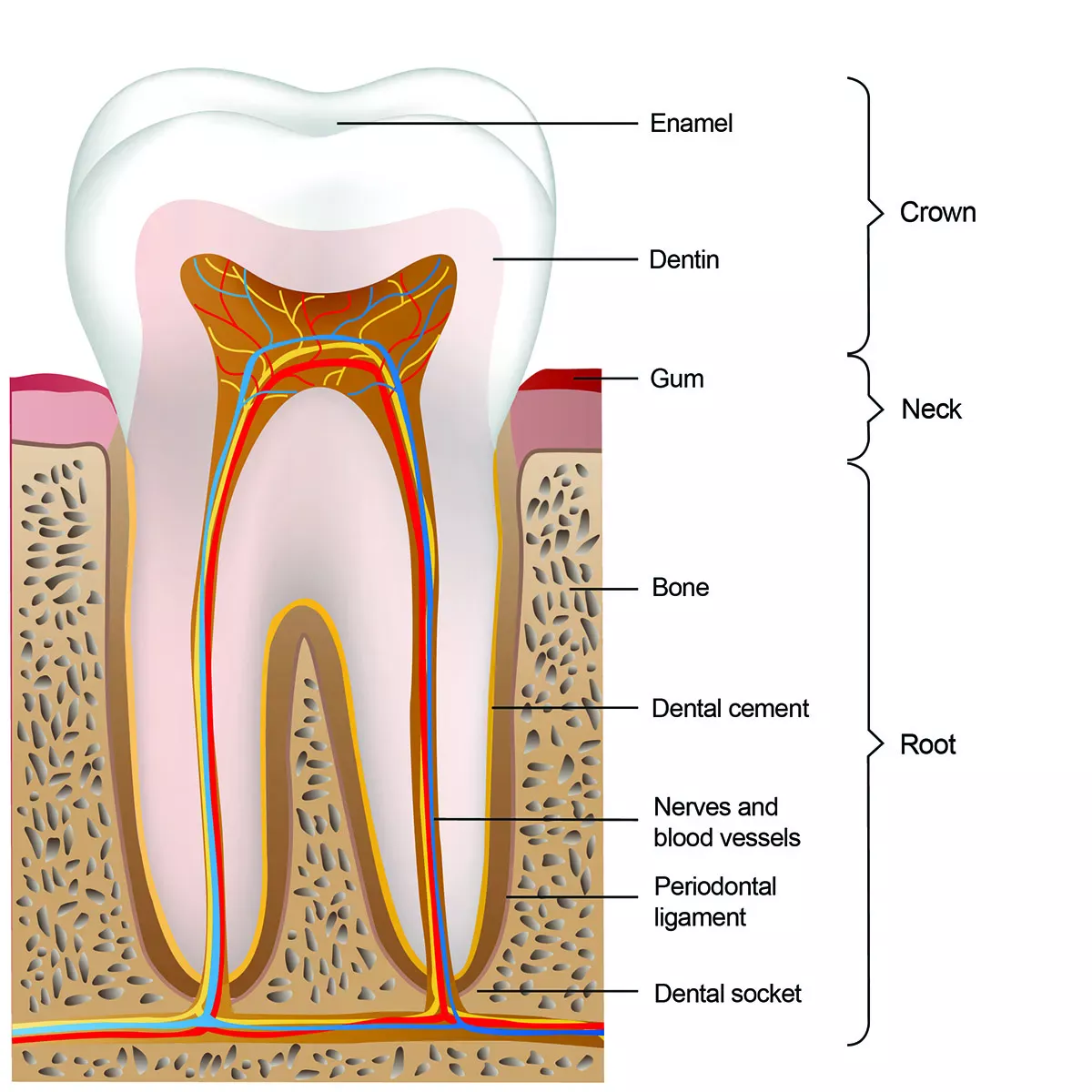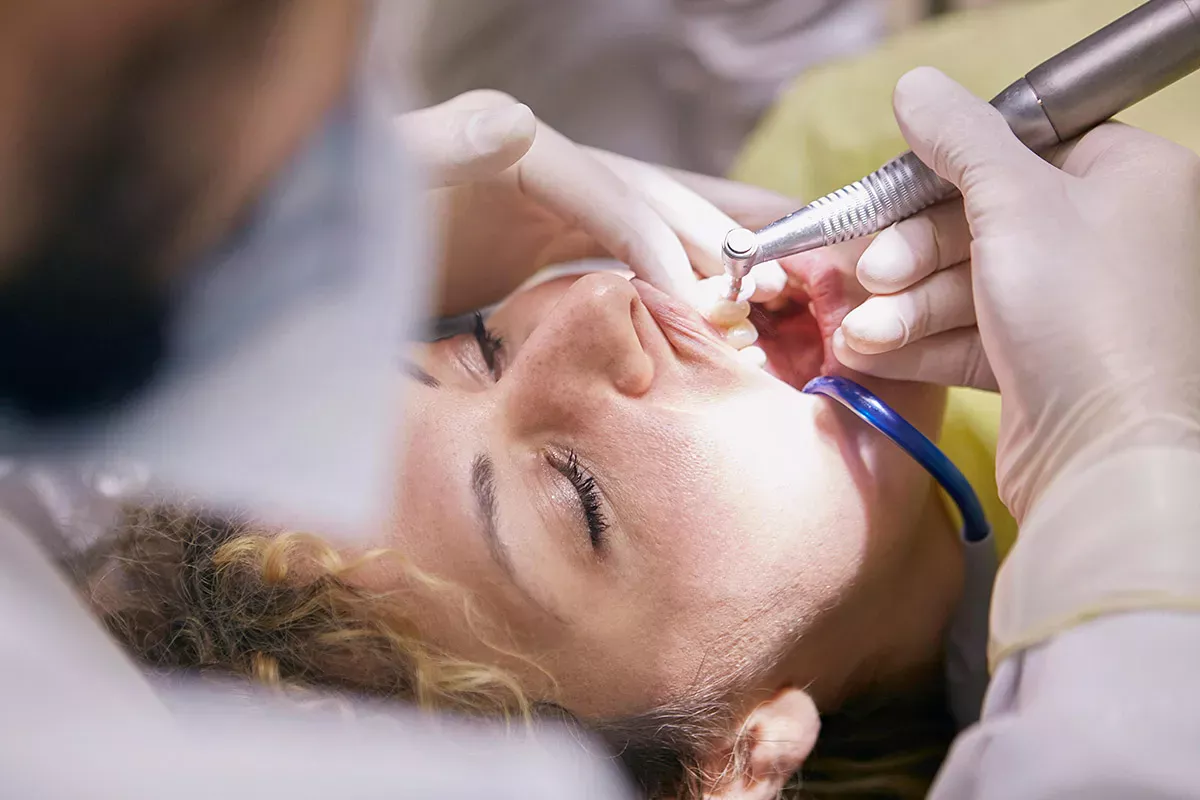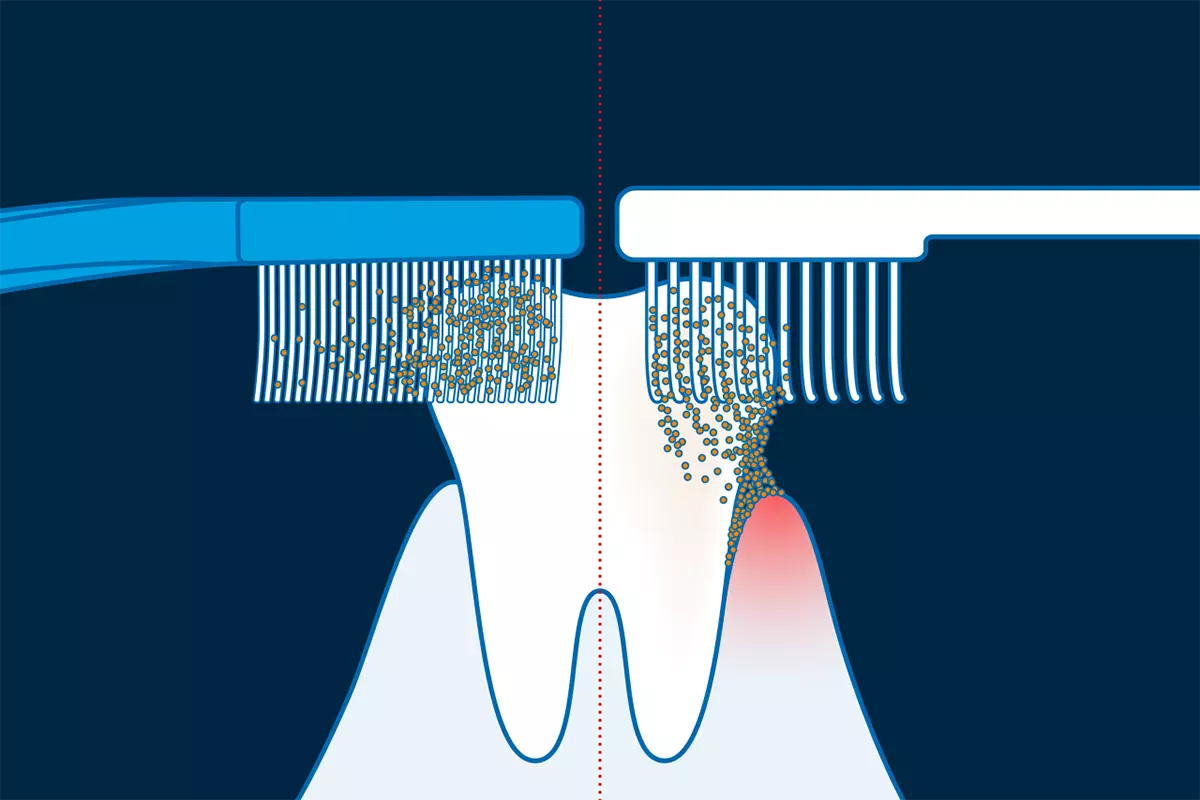Definition: What is tooth enamel?
Tooth enamel (Latin technical term: Substantia adamantina or enamelum) is the outermost layer of the tooth that surrounds the visible part of the tooth, the crown. Beneath it lies the dentin. The function of the enamel is to protect the dentin from acid and bacterial attacks. However, there are no nerve cells or blood vessels in the hard protective layer. Strictly speaking, the cells in the enamel are dead. This is why this tooth layer is completely insensitive to pain. However, this also means that tooth enamel cannot grow back and cannot regenerate itself.
Structure: What is tooth enamel made of?
Tooth enamel consists of 95 per cent inorganic substances; mainly hydroxyapatite, an acid-soluble phosphate. Other components are sodium, magnesium, phosphorus and calcium. The enamel layer can be up to 2.5 millimetres thick. However, the thickness varies from person to person and also from tooth to tooth.
You can imagine enamel as a composition of invisible crystals or prisms that run along the dentin - like a grid matrix. The crystals are grouped together in bundles and are stabilised by interprismatic enamel. Researchers at the University of Hamburg discovered that the secret to the exceptional strength and rigidity of tooth enamel lies in the combination of hard and soft materials. US researchers were able to gain further insights: The individual crystal bundles are not arranged in a row, but rather chaotically. This uneven arrangement makes the enamel particularly resistant.
How hard is tooth enamel?
The hardness of materials is measured on the so-called Mohs scale from 1-10. Tooth enamel has a Mohs hardness of 5.0, compared to 4.0 for iron. In order for dentists to be able to work on tooth enamel, the instruments must be equipped with diamond grains. Diamonds have a Mohs hardness of 10.0 and are considered the hardest material.
What does tooth enamel look like?
When tooth enamel is intact, its crystal structure gives it a slight lustre when exposed to light. The hydroxyapatite also makes the teeth appear slightly whiter. The layer under the enamel, the dentin, is more of a yellowish colour.
Under the scanning electron microscope, enamel shows individual fibres at the lowest level, followed by fibre bundles and a complex weave at the micro level.
Function: Why is tooth enamel important?
The hard enamel layer protects the soft dentin, which is permeated with nerves, from all kinds of discomfort. Only when the enamel is intact can we chew and eat without pain and enjoy a cool refreshment or a warming cup of tea. If the dentin were exposed, it would react with pain to temperature fluctuations, sweet and sour foods. It would also be defenceless against bacteria. Bacteria could eat their way undisturbed into the tooth interior and destroy our teeth.
As you can see, tooth enamel has an extremely important task. It is supported in this by saliva. With every acidic or sweet meal, a small amount of minerals is removed from the enamel. As saliva also contains these minerals, it can refill the tiny holes in the matrix. This process is called remineralisation.
Problems: Enamel degradation and defects
Although tooth enamel can withstand a lot, it is unfortunately not indestructible. In the course of our lives, erosion, recession or even loss of tooth enamel can occur. If the enamel is gone or dissolves, this can have serious consequences for the teeth: Bacteria have an easy time of it and can settle and multiply undisturbed inside the tooth. Teeth without enamel have a significantly increased risk of caries. In addition, teeth become sensitive to pain when the enamel is broken because the resistant protective layer is no longer intact.
Good to know:
Read our article to find out exactly how tooth decay develops, what the right treatment is and how you can best protect yourself:
Symptoms of defects in tooth enamel
You can recognise that your enamel is damaged or gone in certain places by the following symptoms:
- The tooth appears matt or translucent.
- The dentin becomes visible (yellow or brown discolouration).
- The enamel is broken, chipped or flaked off.
- You have a toothache.
- The tooth is suddenly sensitive to pain and temperature.
You can find out what you can do if your teeth are sensitive to pain in our article:
Causes: How do enamel disorders occur?
The breakdown of tooth enamel can be favoured by various factors:
Wear and tear
Every day, tooth enamel has to withstand the pressure of crushing food while chewing. Over the course of a lifetime, it is normal for signs of wear to occur.
Acidic diet
The main component of tooth enamel, hydroxyapatite, is acid-soluble. A highly acidic diet can therefore become a real problem for your tooth enamel. The remineralisation by saliva described above is no longer sufficient to close the small holes in the crystal matrix of the enamel, and acid slowly erodes the layer. This applies to foods that contain acid - for example fruit acid or lactic acid - but also to sugary foods that are metabolised into acid by caries bacteria.
On the one hand, foods that are generally considered unhealthy, such as soft drinks, chocolate, jelly babies, etc., are bad for tooth enamel. On the other hand, various types of acidic fruit are also harmful to tooth enamel, even though they contain important vitamins and other nutrients.
This applies, for example, to:
- Apples
- Strawberries
- Oranges
- Grapes
- Tomatoes
- Salad dressings with vinegar
Mechanical damage to the enamel
If your enamel is gone in places, it may also be because you have brushed it away. Many people use toothbrushes that are too hard and aggressive toothpastes with abrasives. This applies in particular to whitening toothpastes with a high RDA value. This value indicates how strongly a toothpaste attacks the tooth enamel. Anything above 100 is considered harmful and unsuitable for daily use because it removes a small amount of enamel with each brushing. Toothpastes that promise a whitening effect can easily break the 200 mark.
Good to know:
With an RDA value of 90, the 'Black is white' toothpaste from Curaprox has a particularly low value for a whitening toothpaste and relies on the natural power of activated charcoal to bind discolouration.
Teeth grinding
The stress on the enamel when grinding teeth is many times greater than when chewing. This is why people who grind their teeth often suffer from enamel defects. Wearing a grinding splint can protect against further damage.
You can find out what else helps against teeth grinding and why people grind their teeth in the first place in our article:
What to do about teeth grinding?
Frequent vomiting
Just like lactic acid and fruit acid, stomach acid also attacks tooth enamel. This can be a problem, especially for pregnant women who suffer from morning sickness and people with bulimia.
You can find out what else you need to know about dental care and possible dental problems during pregnancy in our article:
Hypoplasia
However, the enamel may already be damaged when the permanent teeth erupt. If this is the case, we speak of enamel hypoplasia or chalky teeth (technical term: molar incisor hypomineralisation). In this malformation, the enamel is much softer than it should be. The teeth are already discoloured, crumbly and sensitive to pain when they erupt. The protective enamel layer has therefore not been able to form properly.
Good to know:
You can find out what you can do about chalky teeth and what the suspected causes are in our article:
How can I rebuild my tooth enamel?
What can be done if tooth enamel is missing or damaged in places? Can it be repaired?
Toothpaste to build up tooth enamel
To remineralise damaged tooth enamel, you can use a toothpaste with hydroxyapatite. This artificially laboratory-produced ingredient is similar to the main component of tooth enamel and is therefore also known as "artificial enamel". When you regularly use a toothpaste with hydroxyapatite, a film of artificial enamel forms on your teeth and closes small cracks and holes. This can reduce sensitivity to pain because the nerve endings in the dentine are no longer exposed.
Your toothpaste should also contain fluoride to strengthen the tooth enamel. The fluoride is deposited in the tooth enamel and supports remineralisation. At the same time, it disrupts the metabolism of caries. Experts believe that the widespread use of fluoride in toothpaste is the reason for the enormous decline in tooth decay in recent decades. To further strengthen tooth enamel, many dentists recommend applying a fluoride gel once a week.
Good to know:
The toothpastes in the 'Be you' range from Curaprox not only taste delicious, but all contain hydroxyapatite to remineralise your tooth enamel. With an RDA value of just 50, they are also particularly gentle on your enamel.
If you want to strengthen your tooth enamel without fluoride, you should make sure you choose a toothpaste that strengthens and protects the enamel with hydroxyapatite or the use of natural enzymes - for example, Enzycal toothpaste without fluoride from Curaprox. It is better not to use a mouthwash because it disrupts your oral flora.
Treatment of defects in tooth enamel at the dentist
Unfortunately, the dentist cannot simply "repair" your tooth enamel. However, they can make sure that the toothache you experience due to the missing protective layer does not occur. For example, you can seal damaged enamel with a special fluoride varnish or have exposed nerve canals sealed with a synthetic material. If there are already larger holes in the enamel and a cavity needs to be treated, your dentist can place an amalgam or ceramic filling.
Chinese researchers have already developed a gel made of calcium and phosphate that binds to existing tooth enamel and forms hydroxyapatite crystals after application. According to a study, this artificial layer is indistinguishable from natural tooth enamel. However, this gel is not yet authorised because the treatment would have to be repeated around 400 times, which makes it unsuitable for use in a dental practice. In addition, its chemical safety still needs to be investigated in studies. However, this milestone gives hope for a future in which tooth enamel can be built up artificially.
Build up tooth enamel naturally
If you don't want to put fluoride on your teeth in the form of toothpaste, you can also drink green or black tea as a home remedy - they contain particularly high levels of fluoride. One litre of black tea covers half the daily requirement of an adult. However, be aware that fluoride does not ensure that the enamel grows back, but merely hardens it. Black tea can also cause discolouration on the teeth.
Schüssler salts
Some people swear by Schüssler salts for all kinds of physical ailments. Schüssler salts No. 12 and 22, for example, are also said to help with tooth enamel defects because they contain calcium fluoride, calcium phosphate and calcium carbonate. So far, however, there is no scientific evidence for the effect of Schüssler salts.
6 tips: How to protect your tooth enamel
It's best to prevent your tooth enamel from dissolving or breaking off in the first place. We have put together the best tips for you here to strengthen or protect your tooth enamel:
1. Have your teeth professionally cleaned twice a year
Professional teeth cleaning is a sensible protective measure for your tooth enamel for two reasons: On the one hand, dental professionals remove plaque and tartar (hardened plaque) particularly thoroughly so that the bacteria in it cannot attack your tooth enamel. On the other hand, a fluoride varnish is usually applied after cleaning, which additionally strengthens your enamel and protects it from caries.
2. Wait to brush your teeth after acidic food and drinks
Acidic foods are poison for your tooth enamel. However, this doesn't mean that you have to give up oranges, grapes and apples completely from now on. After all, these types of fruit also contain many good nutrients. To protect your tooth enamel after eating acidic foods, you should wait at least half an hour before brushing your teeth until your tooth enamel has been remineralised by the saliva. After the acid has removed minerals from the enamel, it is softer. If you brush your teeth straight away, you will damage your enamel. After about half an hour, the saliva has refilled the small holes in the enamel matrix and you can brush your teeth without any problems.
Insider tip: If you drink a glass of water immediately after eating acidic foods, you will weaken the acid attack.
3. Do without snacks
With every sip of cola or bite of chocolate, you cause a new acid attack on your tooth enamel. That's why it's better to drink a glass of lemonade or orange juice quickly instead of sipping it leisurely for hours. The same applies to sweets: treat yourself to a piece of cake or a piece of chocolate as a dessert after a main meal rather than snacking in between meals. Your tooth enamel will thank you if it only has to re-mineralise once.
4. Use a soft toothbrush
Most people think that they are doing their teeth a favour by using a hard toothbrush because it cleans particularly thoroughly. This is not true. A hard toothbrush is too stiff to adapt to the tooth structure and therefore cannot remove all the plaque. It also damages your gums and tooth enamel - especially if you press hard when brushing your teeth. The most thorough - and gentle - cleaning is achieved when you brush your teeth with a soft toothbrush, as the bristles can bend effortlessly and brush the entire tooth surface.
Good to know:
All Curaprox toothbrushes have soft bristles and are therefore particularly gentle on the gums and tooth enamel. The classic - the CS 5460 - is recommended by dentists all over the world and has 5,460 super-fine bristles - around 10 times as many as a conventional toothbrush.
5. Use fluoride-containing toothpaste with a low RDA value
You already know that fluoride hardens tooth enamel and protects against tooth decay. That's why you should definitely use a toothpaste with fluoride to protect your tooth enamel - this applies to children as well as adults. You can find out which fluoride dose is suitable for which age in the fluoride article in the section "Four factors: How to choose the right toothpaste".
To protect your enamel, you should also avoid toothpastes with a high abrasion value (RDA value). This applies in particular to whitening toothpastes, which use mechanical processes to lighten the enamel and remove part of the enamel each time you brush. For healthy teeth, an RDA value of 70 to 100 is fine; people with sensitive teeth should rather use toothpaste with an RDA value below 70 or - even better - below 50.
Good to know:
The 'Be you' toothpastes from Curaprox not only taste delicious and gently whiten teeth in a natural way. At around 50, they have a particularly low RDA value for a whitening toothpaste and do not attack the tooth enamel. They are therefore even suitable for teeth that are sensitive to pain.
6. Use the correct toothbrushing technique
To remove plaque thoroughly, you hardly need to apply any pressure with your toothbrush. Instead, make sure you clean the entire tooth surface - and do so systematically: position the toothbrush so that it points slightly upwards at a 45-degree angle in the upper jaw and slightly downwards in the lower jaw, resting half on the gums and half on the teeth.
Now move the toothbrush in gentle, small circular movements from one side to the other and remember to brush the back of the last molars as well. It's best to start with the insides, which are otherwise easily forgotten. Important: Thorough oral hygiene also includes cleaning the spaces between your teeth - ideally with an interdental brush (for example, the Prime interdental brush from Curaprox)
Want to know what the scientifically proven most efficient tooth brushing technique is? Then take a look at our step-by-step guide:
Sources
Antwerpes, Frank et al: Tooth enamel, at: flexikon.doccheck.com.
Ärzteblatt: Dentistry: Gel allows tooth enamel to regenerate.
Busch, Susanne: Regeneration of human tooth enamel, in: Angewandte Chemie. 2004.
Chemie.de: Iron.
Dentolo: Tooth enamel: How to preserve the natural protective coating.
German Society of Dentistry, Oral and Maxillofacial Medicine (DGZMK): S3 guideline (long version) Diagnosis and treatment of bruxism.
Dr Gal: Strengthening tooth enamel - how to do it right.
Dr Gerald Gaß & Partner: Enamel hypoplasia, at: eckhauspraxis.de.
Dr Jessica Zenner & colleagues: Hypoplastic teeth (MIH, chalk teeth).
Dr Seidel: Tooth enamel - dentine.
Society for Dental Health, Function and Aesthetics: Dead tooth: Tooth turns black or discoloured.
Hahn, Rainer: Auf den Zahn gefühlt, on: deutsche-apotheker-zeitung.de.
Initiative proDente: Insider tip: tea.
IWW Institute: Trend report: Hydroxyapatite - does it remineralise lesions better than fluoride?
Medizin transparent: Schüßler salts: Studies are lacking.
Paál, Gábor: Which is the hardest metal?, on: swr.de.
Shao, Changyu et al: Repair of tooth enamel by a biomimetic mineralisation frontier ensuring epitaxial growth, in: Science Advances. 2019.
Schrör, Sabine: Tooth enamel, on: netdoktor.de.
Toumba, K.J. et al: Guidelines on the use of fuoride for caries prevention in children: an updated EAPD policy document, in: European Archives of Paediatric Dentistry. 2019.
TU Hamburg: Tracking down the secret of tooth enamel.
Zahnarztpraxis Naegeli: Teeth - as hard as diamonds.
ZWP online: Secret revealed: This is why tooth enamel is as hard as steel.
All websites last accessed on 06.01.2013.
 Swiss premium oral care
Swiss premium oral care








